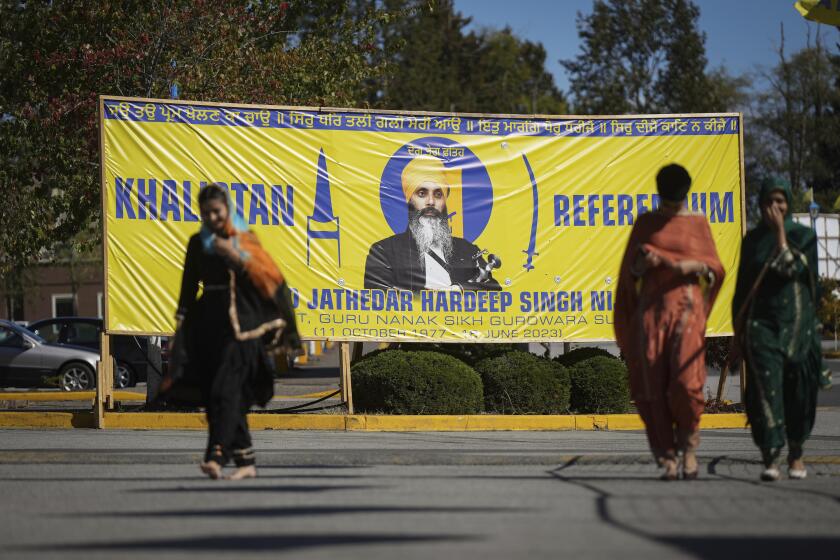Anniversaries Signal That Nation Is Coming of Age : U.S. Is Hot on Birthday Party Circuit
If it’s 200, 100, 75, 50, 25, 10 or just 5 years old and it’s American, there is bound to be a celebration somewhere.
“Let no milestone go unmarked” seems to be the unwritten national law--be it the anniversary of Superman or Snow White, Coca-Cola or Spam, the Statue of Liberty or the Golden Gate Bridge, the birth of a newspaper or the birth of a nation.
“People are searching for a solid foundation, something to hang onto, in a world that keeps changing. It’s the idea of permanence, a link,” says Michael Marsden, professor of popular culture at Bowling Green State University in Ohio.
“We don’t have much history. It pales next to Europe’s, where cities celebrate millennia,” he says. “But almost every American community takes pride in its founding. By observing it, they say, ‘We’ve survived 100 years, we made it.’ ”
Recent Phenomenon
Most people don’t realize how recent and how American the whole birthday phenomenon is, says Roger D. Abrahams, professor of folklore and folk life at the University of Pennsylvania. “ ‘Happy Birthday to You’ is an American song written in the 1890s. In a secular world, we miss the points of passage of the religious world, and we make up for it through the corporate entity. Every town has its festival, and every company finds a way of celebrating itself.”
Celebrations today can be a big business. They are often carried out on unprecedented scales because of high technology and the mass media, says Jack Santino, assistant professor of popular culture at Bowling Green.
“The Statue of Liberty’s unveiling in 1886 couldn’t compare with the elaborate, four-day, international centennial extravaganza in 1986,” he says. “You didn’t have to be there this time. Through satellite hookups, you could watch it on TV.” Millions did.
If it seems as if American anniversaries have proliferated in the last decade or so, it is a sign of a young nation coming of age.
‘A Lot Happened’
“It’s that time of the century. A lot happened in this country in the last quarter of the 1700s,” says Stephen Gold, publications manager of the Commission on the Bicentennial of the U.S. Constitution. The commission lists more than 5,000 events in some 2,200 communities during the official 5-year celebratory period, 1987 through 1991.
The Constitution’s bicentennial is “more than parades and fireworks. It’s an educational effort,” Gold says. “It’s re-educating the American people about the values and principles on which the country was built.”
In 1988 the bicentennial of the document’s ratification will be observed. The Constitution was written in 1787, but did not take effect until the ninth state of the original 13, New Hampshire, ratified it on June 21, 1788. The bicentennial observances will not end until Dec. 15, 1991, the anniversary of the day the Bill of Rights took effect, with Virginia’s ratification.
1988 Events
Lest we forget any anniversaries, almanacs faithfully announce them each year. Among centennials listed for 1988 are:
First patents on the roll film and a simple box camera, the Kodak, and on a revolving door, ball-point pen, and artificial drinking straw. Invention of the alternating-current (AC) “electromagnetic motor” that made the universal transmission and distribution of electricity practicable.
Launching of National Geographic magazine. Public opening of the Washington Monument, the the world’s tallest masonry structure. First U.S. use of the “Australian ballot,” the secret, uniform printed ballot. Publication of Edward Bellamy’s utopian novel, “Looking Backward, (2000 to 1887).”
Historian William H. Goetzmann wrote in the January, 1988, National Geographic that the 1880s ushered in the electrical age: “self-propelled electric vehicles, a street railway in Richmond, Va., an entirely lighted ocean liner, a brightly lit-up Wall Street district, telephone and telegraph systems, and even phonographs . . . and the electric chair.”
Many Societies Formed
The formation of societies, Goetzmann writes, was “just one expression of the demand for progress through organization and efficiency spawned by the experience of handling large numbers of men and machines during the Civil War.” In 1888 alone, the Geological Society of America, American Society of Church Histories, National Geographic Society, American Folklore Society, and American Mathematical Society were formed.
Not forgetting its heritage in 1988, the College of William and Mary in Williamsburg, Va., will help celebrate the 300th anniversary of the “Glorious Revolution,” the bloodless English rebellion that put King James II’s daughter Mary and her husband, Prince William III of Orange, from the Netherlands, on the throne.
“We feel a good deal of kinship with these monarchs because they founded our institution in 1693,” says William N. Walker, college spokesman. The college plans a series of cultural events and has been designated by Congress as the official U.S. representative to international celebrations in England and the Netherlands.
Perhaps the biggest jubilee of all will be in 1992--the 500th anniversary of the discovery of the New World.
Little heed has been paid to Mark Twain, who wrote in 1896: “Anniversaries are very well up to a certain point. . . . They are joy-flags that make gay the road and prove progress; and one looks down the fluttering rank with pride. Then presently one notices that the flagstaffs . . . are turning into milestones. They are marking something lost now, not gained. From that time on it were best to suppress taking notice of anniversaries.”
More to Read
Start your day right
Sign up for Essential California for news, features and recommendations from the L.A. Times and beyond in your inbox six days a week.
You may occasionally receive promotional content from the Los Angeles Times.






